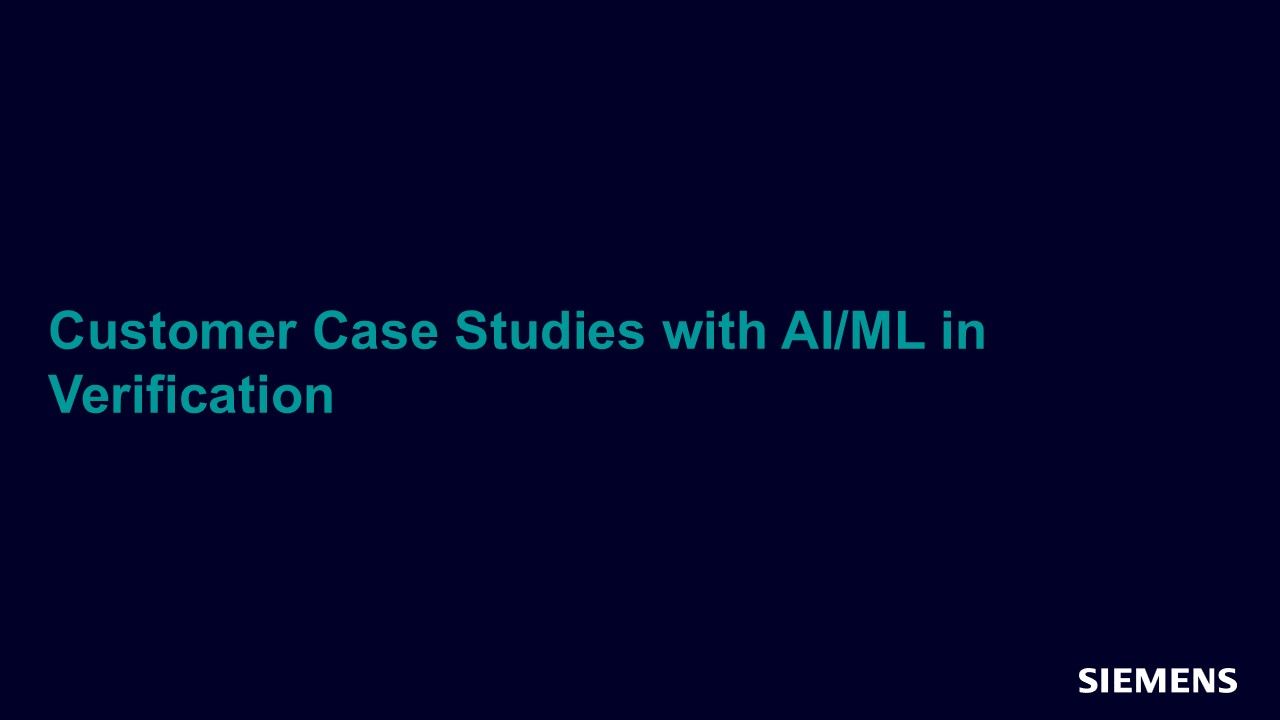Search Results
Filters
Advanced Search
2154 Results
-
New AI Horizons in Static & Formal Verification
Resource (Recording) - Apr 24, 2024 by Dan Yu
-
New AI Horizons in Static & Formal Verification
Resource (Slides (.PDF)) - Apr 24, 2024 by Dan Yu
-
Optimizing FPGA Equivalence Checking for A&D Designs
Resource (Slides (.PDF)) - Apr 24, 2024 by Kevin Urish
-
Driving Efficient Execution with Continuous Integration
Resource (Slides (.PDF)) - Apr 24, 2024 by Kevin Campbell
-
Enverite PV-Bit: Bitstream Verification for FPGA Design Assurance
Resource (Slides (.PDF)) - Apr 24, 2024 by Dr. Jonathan Graf
-

osmosis Aerospace and Defense 2024
Conference - Apr 24, 2024 by John Hallman
osmosis Aerospace and Defense (A&D) is about sharing the success in using formal techniques to address the demanding verification requirements and challenges of Trust and Assurance verification, Safety Critical Designs, and DO-254 compliant and other high-consequence systems.
-
Win the Tick to Trade Race by Root Causing Bugs Faster with QuestaSim
Resource (Slides (.PDF)) - Apr 16, 2024 by Rich Edelman
In this webinar we will highlight the key innovations in QuestaSim that enable full debug visibility with significant reduction in simulation performance overhead and waveform database size.
-

Win the Tick to Trade Race by Root Causing Bugs Faster with QuestaSim
Webinar - Apr 16, 2024 by Rich Edelman
Root causing RTL design or simulation testbench bugs can be tedious process, especially if just relying on traditional waveform viewing and debug. Also, it can be costly if more sophisticated debug ties up precious simulation resources during the debug process.
-

Lost in Code: Using Visualizer to Understand Someone’s UVM Testbench
Conference - Apr 04, 2024 by Salil Pandit, Robert Rice - Siemens EDA
It's always challenging for Design-Verification engineers to take over the ongoing complex testbench work from another engineer who is no longer working on the given project. In this presentation, we walk through 5 concrete steps you can take to fully understand a “new to you” UVM testbench.
-
Lost in Code: Using Visualizer to Understand Someone’s UVM Testbench
Resource (Slides (.PDF)) - Apr 04, 2024 by Salil Pandit, Robert Rice - Siemens EDA
It's always challenging for Design-Verification engineers to take over the ongoing complex testbench work from another engineer who is no longer working on the given project. In this presentation, we walk through 5 concrete steps you can take to fully understand a “new to you” UVM testbench.
-

Why and How We Migrated from In-house Regression Management and Coverage Flow to Verification IQ
Conference - Apr 04, 2024 by Avinash Agrawal - Siemens EDA
In this session we share how we worked with a customer to migrate from a sophisticated array of home-grown spreadsheets and scripts to process coverage analysis automation with Questa Verification IQ.
-
Why and How We Migrated from In-house Regression Management and Coverage flow to Verification IQ
Resource (Slides (.PDF)) - Apr 04, 2024 by Avinash Agrawal - Siemens EDA
In this session we share how we worked with a customer to migrate from a sophisticated array of home-grown spreadsheets and scripts to process coverage analysis automation with Questa Verification IQ.
-

How and Why We Adopted Questa Core in the Development of Quantum Computers
Conference - Apr 04, 2024 by Jan Marjanovic - Atom Computing
This session starts with the introduction of our quantum computers and their control system, presents the challenges of verifying designs of decent complexity with constantly-changing requirements, discusses advantages and disadvantages of using Vivado Simulator and Questa Core for verification, and touches on the challenges of integrating Vivado and Questa Core.
-
How and Why We Adopted Questa Core in the Development of Quantum Computers
Resource (Slides (.PDF)) - Apr 04, 2024 by Jan Marjanovic - Atom Computing
This session starts with the introduction of our quantum computers and their control system, presents the challenges of verifying designs of decent complexity with constantly-changing requirements, discusses advantages and disadvantages of using Vivado Simulator and Questa Core for verification, and touches on the challenges of integrating Vivado and Questa Core.
-

How We Use PCIe Verification IP Across Multiple Projects
Conference - Apr 04, 2024 by Weiping Guo - Marvell
In this session we will discuss how Marvell delivers successful products and drives the market by with a structured design and verification methodology that reflects this philosophy. Specifically, we will dive deep into one of the most complex protocols: PCIe IP and the related testbench architecture; and how we adopted Siemens’ PCIe Avery Verification IP.
-
How We Use PCIe Verification IP Across Multiple Projects
Resource (Slides (.PDF)) - Apr 04, 2024 by Weiping Guo - Marvell
In this presentation we will discuss how Marvell delivers successful products and drives the market by with a structured design and verification methodology that reflects this philosophy. Specifically, we will dive deep into one of the most complex protocols: PCIe IP and the related testbench architecture; and how we adopted Siemens’ PCIe Avery Verification IP.
-

Customer Case Studies with AI/ML in Verification
Conference - Apr 04, 2024 by Karim Ameziane
In this session we will share some results from our customer partnerships on how AI/ML is helping them with particular verification needs. The common thread: in order to apply advanced ML techniques to bring more value to verification, we show how to focus on building data assets that will put a verification team on the path to ML success.
-
Customer Case Studies with AI/ML in Verification
Resource (Slides (.PDF)) - Apr 04, 2024 by Karim Ameziane - Siemens EDA
In this session we will share some results from our customer partnerships on how AI/ML is helping them with particular verification needs. The common thread: in order to apply advanced ML techniques to bring more value to verification, we show how to focus on building data assets that will put a verification team on the path to ML success.
-
The Importance of Simulation in the Pursuit of Absolute Speed!
Resource (Verification Horizons Blog) - Apr 02, 2024 by Sunil Sahoo
I recently had an opportunity to talk to someone who worked in the high-frequency trading (HFT) sector a few years ago. I wanted to know how they performed their functional simulations. If you know anything about HFT or low-latency trading, you know that those engineers are very secretive and don’t divulge a lot of details about what their FPGA design-verification process entails.
-
Questa Check Connect Fact Sheet
Resource (Fact Sheet) - Apr 01, 2024 by Nicolae Tusinschi
Questa Check Connect offers a distinct approach for verifying interconnect integrity within designs. It facilitates scalable verification for extra-large System-on-Chips (SoCs) through automated and exhaustive formal analysis. The solution is designed for easy deployment, delivering unique capabilities for conclusive results in complex connectivity challenges that surpass traditional capacity limits.
-
Questa Check Register Fact Sheet
Resource (Fact Sheet) - Apr 01, 2024 by Nicolae Tusinschi
Questa Check Register guarantees the alignment of register implementations with specifications. It seamlessly reads RTL descriptions and register specifications from either IP-XACT or a custom format, then generates assertions for verifying memory-mapped registers. It promptly detects all RTL related functional concerns tied to registers. Additionally, it offers effortless monitoring of progress through the Questa verification management tool.
-
Reduce Gate-level Simulation Bring-up Time with Semi-formal X Verification
Resource (Slides (.PDF)) - Mar 27, 2024 by Rick Koster
Gate-level simulations (GLS) are a crucial step in the verification of an ASIC/FPGA. GLS is used for verifying power-up, reset operation, timing, multi-cycle paths, and power estimation. However, GLS can be a bottleneck in the project cycle due to its complexity.
-

Reduce Gate-level Simulation Bring-up Time with Semi-formal X Verification
Webinar - Mar 27, 2024 by Rick Koster
This session will describe a reliable formal-based method to manage Xs in GLS. It centers on the use of Siemens Avery SimXACT solution alongside your preferred simulator.
-
In Memoriam: Chris Spear
Resource (Verification Horizons Blog) - Mar 14, 2024 by Tom Fitzpatrick
Our friend and colleague Chris Spear passed away suddenly. He was a long-time veteran of our industry and was known and respected by many.
-
New Advanced Techniques for Reset Domain Crossing (RDC) Analysis
Resource (Slides (.PDF)) - Mar 14, 2024 by Atul Sharma
In this session, you will learn new RDC, methodology, and automation techniques including; how to hierarchically characterize and structure reset (and clock) domain models for rapid analysis and re-use of IP-level RDC information as the design grows, waiver management flows, creating custom synchronizers and considerations for low power designs with UPF.